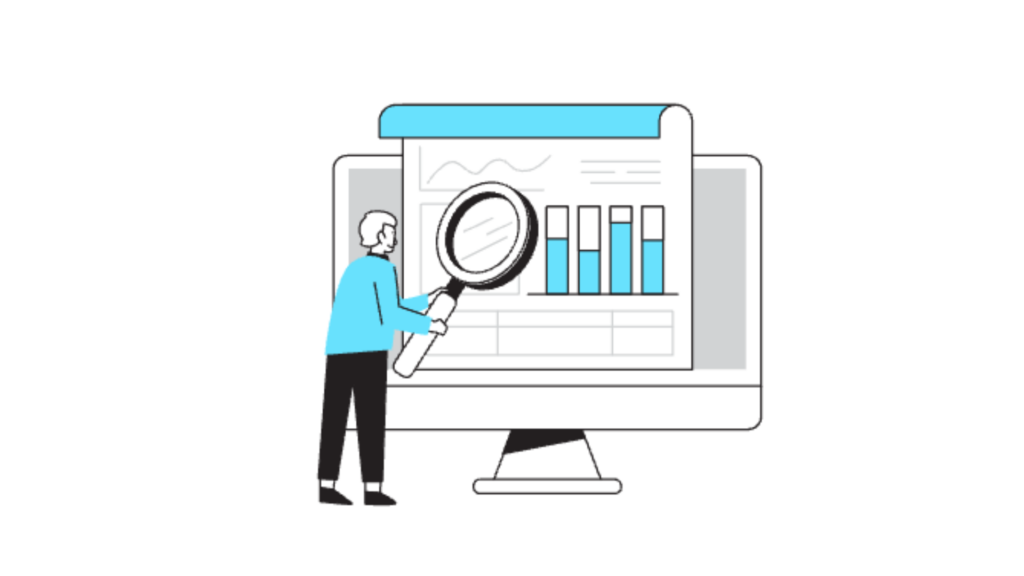What is the First Step in the Marketing Research Process?

Have you ever found yourself pondering, “What exactly is the marketing research process?” If so, you’re not alone. This crucial step in understanding market dynamics, customer preferences, and potential areas for growth can seem daunting at first. Yet, it’s the cornerstone of making informed decisions that drive success. So, let’s embark on a journey to demystify this process, making it both accessible and engaging.
Marketing Research Process: A Brief Overview
The marketing research process is a systematic approach to gathering, analyzing, and interpreting information to make informed marketing decisions.

It helps businesses understand their target audience, market trends, and the effectiveness of their marketing strategies.
Step 1: Identifying the Research Problem
At the heart of every marketing research project is a problem or question that needs answering. This initial step involves pinpointing the exact nature of the issue at hand, whether it’s understanding customer needs, gauging market trends, or assessing the effectiveness of a current marketing strategy.
For example, a company might recognize that despite high website traffic, their conversion rates are low. Identifying this discrepancy as the research problem is the first step towards finding a solution.
Step 2: Developing the Research Plan
Once the problem is identified, the next step is crafting a detailed research plan. This blueprint outlines the research objectives, the data needed, how it will be gathered, and the methods for analysis.
For instance, if a business aims to improve customer satisfaction, the plan might include conducting surveys and focus groups to collect primary data, supplemented by analyzing social media feedback for qualitative insights.
Step 3: Collecting the Data
The data collection phase is where the groundwork begins. Depending on the research objectives, this might involve primary research methods like surveys and focus groups to gather firsthand information, or secondary research methods to analyze existing data. When collecting data from multiple online sources, using high-speed residential proxies can ensure stable, efficient access without triggering blocks or restrictions.
The choice of method depends on the specific needs of the marketing research project, with an emphasis on gathering high-quality, relevant data that can provide actionable insights.
Step 4: Analyzing the Data
With the data in hand, the next step is to sift through it to identify patterns, trends, and insights. This involves a mix of qualitative and quantitative methods, from statistical analysis to thematic exploration of feedback.

The goal here is not just to collect data, but to turn it into meaningful information that can address the research problem.
For example, analyzing customer feedback can reveal common themes that point to specific areas for improvement.
Step 5: Interpreting the Findings
Analysis alone isn’t enough; the next step is to interpret the findings in the context of the initial research problem. This involves translating the raw data and analysis into actionable insights.
For instance, if research shows a gap in customer expectations versus experience, this step would involve understanding the reasons behind this gap and its implications for the business.
Step 6: Reporting the Findings
After analysis and interpretation, it’s time to compile the research findings into a comprehensive report. This document should not only present the data but also provide clear, actionable insights and recommendations based on the research objectives.
It’s crucial that this report is accessible to the internal audience, such as the marketing team, to inform future marketing decisions.
Step 7: Making Informed Decisions
The ultimate goal of the marketing research process is to inform decision-making. With the detailed findings and insights from the research report, businesses can make strategic choices about product development, marketing strategies, and customer engagement.

This step is about translating insights into action, whether it’s tweaking a marketing campaign or rethinking a product offering based on customer feedback.
Step 8: Monitoring and Review
Finally, the marketing research process doesn’t end with the implementation of decisions. It’s important to continuously monitor the outcomes of those decisions and review the impact against the initial objectives.
This ongoing process ensures that the business remains aligned with its target market and can adapt to changing market conditions and customer needs.
For example, regular analysis of sales data and market share can indicate whether adjustments are needed to maintain or improve market position.
Step 9: Refining Research Objectives
As the marketing research process evolves, so too may the initial research objectives. This step involves revisiting and refining these objectives in light of preliminary findings or new information.
It’s not uncommon for the focus of a marketing research project to shift as more data becomes available.
For example, what began as an investigation into general customer satisfaction might narrow down to explore specific aspects, such as satisfaction with customer service.
This refinement ensures that research efforts are targeted and relevant, maximizing the utility of the resources spent on conducting marketing research.
Step 10: Expanding Data Sources
To enhance the depth and breadth of research data, expanding the pool of data sources is a critical step.
This might involve incorporating more diverse secondary data, such as industry reports or competitor sales data, or exploring additional methods of primary research, like social media listening or in-depth interviews.
The aim here is to build a comprehensive dataset that covers as many relevant facets of the research problem as possible.
By broadening the scope of data sources, researchers can uncover nuanced insights and ensure a robust foundation for analysis and decision-making.
Step 11: Iterative Testing and Validation
A key aspect of the marketing research process involves iterative testing and validation of findings. This could take the form of conducting pilot studies, employing exploratory research methods, or testing hypotheses through controlled experiments.
The goal here is to validate initial research questions and findings with a smaller, targeted audience before full-scale implementation. This step is crucial for minimizing risks associated with business decisions and enhancing the reliability of research outcomes.
For instance, testing marketing messages on focus groups before a wider campaign launch can provide valuable feedback that shapes the final strategy.
Step 12: Integrating Market Research with Business Strategy
Integrating the findings from market research into the broader business strategy is an essential step. This involves translating the key insights and recommendations from the marketing research reports into actionable strategies that align with the company’s overall objectives.
Whether it’s adapting marketing tactics, developing new products, or targeting new customer segments, this step ensures that the insights generated from market research directly inform strategic planning and execution.
Collaboration between the marketing team and other strategic planning units within the organization is key to ensuring that research findings are effectively incorporated into business decisions.
Step 13: Continuous Monitoring and Learning
The final step in the extended marketing research process is the commitment to continuous monitoring and learning. Marketing is an ever-evolving field, with customer preferences, market conditions, and competitive landscapes constantly changing.
As such, conducting marketing research is not a one-time task but an ongoing activity. Regularly gathering data, analyzing trends, and updating research methodologies ensure that the organization stays ahead of the curve.
This step involves not just looking at sales data or market share but also keeping an eye on social media trends, customer feedback channels, and other real-time data sources. It’s about creating a culture of continuous improvement, where every piece of data is an opportunity to learn more about the target audience and refine marketing strategies accordingly.
What is Best Method for Primary Research
Surveys: A Versatile Tool for Broad Insights
Surveys stand out as a versatile and widely used primary research method. They allow researchers to gather data on a variety of topics from large groups of people, making them ideal for exploring customer preferences, behaviors, and needs. The key to effective surveys is in their design: questions must be clear, concise, and tailored to the research objectives. For instance, a company considering a new product launch might use surveys to assess potential customer interest and willingness to purchase. This method is particularly valuable for collecting quantitative data that can inform marketing strategies and business decisions.
Interviews: Deep Dives into Customer Psyche
Interviews offer a more in-depth approach to primary research, providing qualitative insights into the thoughts, feelings, and experiences of participants. This method is invaluable when exploring complex issues or understanding the motivations behind customer behavior. Conducting interviews can range from structured formats with set questions to more open-ended, conversational styles. A marketing research project might use interviews to explore the reasons behind customer satisfaction or dissatisfaction, offering a detailed view of the market’s needs and preferences.
Focus Groups: Gathering Collective Perspectives
Focus groups are a dynamic research method where a small group of people discusses a particular topic or product under the guidance of a moderator. This setting encourages participants to interact, offering rich qualitative data and a range of viewpoints. Focus groups are particularly effective for testing new product concepts, advertising messages, or packaging designs, providing immediate feedback and insights that can be used to refine marketing strategies. They offer a unique glimpse into the collective psyche of the target market, making them a key tool in the marketing research process.
Observational Research: The Silent Witness
Observational research involves watching how people behave in natural or controlled environments without direct interaction. This method can unveil how customers use products or interact with brands in real life, offering unfiltered insights into actual behaviors rather than reported ones. Retail businesses, for example, might use observational research to understand shopping behaviors and optimize store layouts accordingly. Although it’s more challenging to categorize and analyze, the data gathered from observations can significantly enhance the understanding of consumer habits.
Experimental Research: Testing and Learning
Experimental research is a method used to establish cause-and-effect relationships by manipulating one or more variables while keeping others constant. This approach is crucial for testing hypotheses about market behaviors or product features. For instance, a company might use experimental research to determine the impact of different pricing strategies on sales. By systematically altering prices and observing the outcomes, businesses can gather concrete evidence about what works best, directly informing pricing and marketing strategies.
Case Studies: Comprehensive Analysis of a Single Instance
Case studies involve an in-depth examination of a particular event, situation, or individual over time. This method provides comprehensive insights into complex marketing problems by exploring them from multiple angles. Case studies are especially useful for documenting instances of successful marketing strategies or analyzing the reasons behind a product’s failure in the market. They offer detailed narratives that can highlight best practices, lessons learned, and strategies that companies can adapt and apply.
Ethnographic Research: Immersion in the Customer World
Ethnographic research is a qualitative method derived from anthropology, involving the researcher immersing themselves in the community or context they are studying. This deep dive into the customer’s world is invaluable for understanding cultural trends, lifestyle factors, and user experiences that influence buying decisions. For example, a brand looking to enter a new market might use ethnographic research to understand the local culture and tailor its offerings accordingly. This method requires significant time and resources but can provide unparalleled insights into customer needs and behaviors.
Content Analysis: Mining Existing Data for New Insights
While content analysis is often associated with secondary research, it can also be applied to primary data sources like social media posts, customer reviews, and open-ended survey responses. This method involves systematically analyzing textual or visual content to identify patterns, themes, and meanings. For marketing research, content analysis can uncover trends in customer sentiment, brand perception, and emerging market needs. By analyzing the content created by or about their target audience, businesses can gain a deeper understanding of the market landscape and how to position themselves effectively within it.
What is Best Method for Secondary Data Research
Literature Review: Exploring Existing Knowledge
A literature review is foundational for any secondary data research, providing a comprehensive overview of existing academic and industry-specific publications related to the marketing research problem. This method involves systematically gathering, reviewing, and synthesizing existing research to identify trends, gaps, and insights relevant to the current study. For instance, a company facing declining sales might conduct a literature review to understand broader market trends and factors influencing buyer behaviors. This approach helps to build a theoretical framework for analyzing data and guiding research activities, ensuring that the marketing research plan is informed by a thorough understanding of the subject matter.
Industry Reports: Leveraging Expert Insights
Utilizing industry reports is a key method for conducting marketing research, offering expert analysis and forecasts on market trends, competition, and consumer behavior. These reports provide a high-level overview of the industry, including key performance indicators, market share, and potential areas for growth or concern. A business considering entering a new market might rely on these reports to gather background information and assess the viability of their product. Industry reports serve as a valuable source of secondary data, enabling companies to make informed decisions without the need for extensive primary data collection.
Competitor Analysis: Understanding Market Position
Competitor analysis is crucial for any marketing research project, providing insights into the strategies, strengths, and weaknesses of other players in the market. This method involves collecting data on competitors’ products, pricing, marketing strategies, and customer reviews. The objective is to identify opportunities for differentiation and areas for improvement. For example, a company looking to increase its market share might analyze competitors’ social media posts and marketing campaigns to identify trends and gaps they can exploit. Competitor analysis helps businesses to refine their marketing research plan and develop strategies that capitalize on market dynamics.
Government and Public Records: Accessing Reliable Data
Government and public records offer a treasure trove of reliable, authoritative data for researchers. This method involves exploring data from sources like national statistics offices, regulatory bodies, and public sector research. These records can provide valuable insights into demographic trends, economic indicators, and regulatory environments that affect consumer behavior and market opportunities. For instance, a company planning to launch a new product might use census data to analyze potential customer demographics and target market segments. Utilizing public records ensures that research is grounded in accurate and comprehensive data.
Case Studies: Gleaning Insights from Real-World Examples
Analyzing case studies from similar businesses or marketing campaigns provides concrete examples of strategies that worked or failed. This method offers in-depth insights into practical applications of marketing theories and strategies, highlighting key findings that can inform a company’s own marketing research projects. For example, a brand looking to improve customer satisfaction might study case studies of companies that have successfully implemented customer loyalty programs. Case studies enhance secondary data research by offering detailed narratives that illustrate the complexities of business problems and their solutions for data collection methods.
Academic Journals: Tapping into Scholarly Research
Academic journals are a critical resource for secondary data research, offering peer-reviewed studies and scholarly articles on a wide range of topics related to marketing research. These journals provide rigorous analyses and findings that can add depth and credibility to a marketing research project. By reviewing studies related to their research objective, companies can gain insights into research methodologies, data analysis techniques, and the latest findings in their field. This approach is particularly useful for addressing complex marketing problems that require a deep understanding of theoretical concepts and empirical evidence to conduct marketing research and market research process.
Market Surveys and Polls: Utilizing Existing Surveys
Existing market surveys and polls can offer valuable insights into consumer attitudes, preferences, and behaviors without the need for primary data collection. This method involves reviewing and analyzing surveys conducted by industry associations, research firms, or other organizations. For example, a company interested in customer opinions on sustainable products might analyze data from surveys on consumer attitudes toward environmental responsibility. This approach allows businesses to gather information on their target audience and market trends quickly and cost-effectively for qualitative research.
Trade Associations and Professional Organizations: Networking for Data
Engaging with trade associations and professional organizations provides access to a wealth of industry-specific data, reports, and networking opportunities. These organizations often conduct their own research, surveys, and studies that can be invaluable for secondary data research. For instance, a business seeking to understand the latest technological advancements in their sector might turn to publications and workshops offered by relevant trade associations. This method not only enriches the marketing research plan with specialized insights but also offers opportunities for collaboration and information sharing within the industry.



